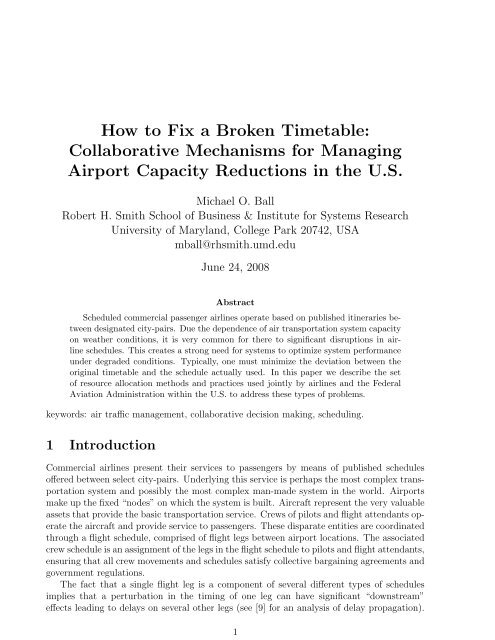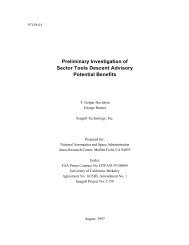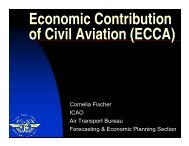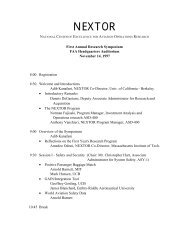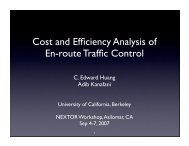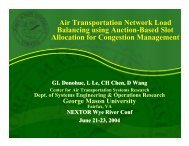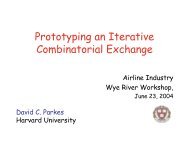How to Fix a Broken Timetable: Collaborative Mechanisms for ...
How to Fix a Broken Timetable: Collaborative Mechanisms for ...
How to Fix a Broken Timetable: Collaborative Mechanisms for ...
- No tags were found...
Create successful ePaper yourself
Turn your PDF publications into a flip-book with our unique Google optimized e-Paper software.
<strong>How</strong> <strong>to</strong> <strong>Fix</strong> a <strong>Broken</strong> <strong>Timetable</strong>:<strong>Collaborative</strong> <strong>Mechanisms</strong> <strong>for</strong> ManagingAirport Capacity Reductions in the U.S.Michael O. BallRobert H. Smith School of Business & Institute <strong>for</strong> Systems ResearchUniversity of Maryland, College Park 20742, USAmball@rhsmith.umd.eduJune 24, 2008AbstractScheduled commercial passenger airlines operate based on published itineraries betweendesignated city-pairs. Due the dependence of air transportation system capacityon weather conditions, it is very common <strong>for</strong> there <strong>to</strong> significant disruptions in airlineschedules. This creates a strong need <strong>for</strong> systems <strong>to</strong> optimize system per<strong>for</strong>manceunder degraded conditions. Typically, one must minimize the deviation between theoriginal timetable and the schedule actually used. In this paper we describe the se<strong>to</strong>f resource allocation methods and practices used jointly by airlines and the FederalAviation Administration within the U.S. <strong>to</strong> address these types of problems.keywords: air traffic management, collaborative decision making, scheduling.1 IntroductionCommercial airlines present their services <strong>to</strong> passengers by means of published schedulesoffered between select city-pairs. Underlying this service is perhaps the most complex transportationsystem and possibly the most complex man-made system in the world. Airportsmake up the fixed “nodes” on which the system is built. Aircraft represent the very valuableassets that provide the basic transportation service. Crews of pilots and flight attendants operatethe aircraft and provide service <strong>to</strong> passengers. These disparate entities are coordinatedthrough a flight schedule, comprised of flight legs between airport locations. The associatedcrew schedule is an assignment of the legs in the flight schedule <strong>to</strong> pilots and flight attendants,ensuring that all crew movements and schedules satisfy collective bargaining agreements andgovernment regulations.The fact that a single flight leg is a component of several different types of schedulesimplies that a perturbation in the timing of one leg can have significant “downstream”effects leading <strong>to</strong> delays on several other legs (see [9] <strong>for</strong> an analysis of delay propagation).1
This “fragility” is exacerbated by the fact that most of the largest carriers rely heavilyon hub-and-spoke network configurations that tightly inter-connect flights <strong>to</strong>/from manydifferent “spokes” at the network’s hubs. Thus, any significant disturbance at a hub, rapidlyleads <strong>to</strong> disruptions of extensive parts of the carrier’s schedules. The fact that the number ofscheduled operations has grown very close <strong>to</strong> the capacity of many airports <strong>to</strong>gether with therelative frequent occurrence of capacity-reducing weather events means that the system goesin<strong>to</strong> a mode of “irregular operations” quite frequently. Under such conditions the timetablesset up between specific city-pairs become severely disrupted. It is not unusual <strong>for</strong> manyflights <strong>to</strong> arrive very late and also flight cancelations can be common.In response <strong>to</strong> the strong economic incentives <strong>to</strong> per<strong>for</strong>m as well as possible under degradedconditions, there has been significant research (e.g. see [1], [20], [21]) and commercialproducts aimed at improving per<strong>for</strong>mance in such situations.There is a particular aspect <strong>to</strong> the problem of providing good operational per<strong>for</strong>mancewithin aviation that is somewhat unique among transportation sec<strong>to</strong>rs. In aviation, an airnavigation service provider (ANSP) plays a very strong role in both insuring the safety ofaviation operations and also in their overall per<strong>for</strong>mance. Specifically, ANSP’s, such asthe Federal Aviation Administration (FAA) in the U.S. and Eurocontrol, in Europe, haveresponsibility <strong>for</strong> overall airspace management and as such are interested in achieving highlevels of system-wide per<strong>for</strong>mance. These entities must work collaboratively with fligh<strong>to</strong>pera<strong>to</strong>rs, including large scheduled air carriers, various business jet opera<strong>to</strong>rs offering arange of services and also, individual general aviation pilots. In this paper we focus on a se<strong>to</strong>f systems and concepts that very specifically tries <strong>to</strong> “optimize” the relationship betweenan ANSP and the flight opera<strong>to</strong>rs. <strong>Collaborative</strong> Decision Making (CDM)(also known as<strong>Collaborative</strong> Air Traffic Management) has developed over the past 15 years both in theU.S. and Europe (see [4], [10], [12],[18]). CDM makes up a body of knowledge that consistsof a set of operational concepts, decision principles and algorithms and most broadly anoverarching philosophy. Several operational systems and computer-based decision support<strong>to</strong>ols have been based upon it. At this point, any “modern” air traffic management solutionmust embody certain CDM principles.The second aspect of the focus of this paper involves the general problem area of grounddelay program (GDP) planning within the U.S. GDP planning and control represents theproblem domain within which CDM principles were initially developed. As such it hasthe richest his<strong>to</strong>ry and most completely developed mechanisms. Further, many aspects ofthis problem deal very explicitly with the timetable structure of airline schedules and theconstraints this structure places on how services can be dynamically adjusted based onadverse conditions.Section 2 of this paper describes the basic principles of CDM-based GDP planning andcontrol as well as the impact the move <strong>to</strong> CDM principles produces. Section 3 reviews morerecent research and emerging principles and systems.2
ation-by-schedule(RBS)cancellationsandsubstitutionscompressionFigure 1: CDM Resource Allocation2 <strong>Collaborative</strong> Ground Delay Program Planning andControlThe FAA continuously moni<strong>to</strong>rs airports throughout the US <strong>for</strong> capacity-demand imbalances.Whenever it predicts that the number of flights arriving at an airport within a 15-minuteinterval exceeds the capacity of the current runway configuration, FAA directives mandatea response [11]. Short periods of congestion are usually resolved by airborne tactics, suchas re-routing and variations in airborne speed. GDPs on the other hand primarily addresslonger periods of congestion at an airport. Usually, a GDP spans a period of 4 hours orlonger, and is initiated 3-4 hours in advance.Prior <strong>to</strong> the implementation of GDP enhancements under CDM, arrival slots were assigned<strong>to</strong> flights by a first-come, first-served algorithm affectionately known as Grover Jack.The affected flights were ordered according <strong>to</strong> their most recent estimated arrival times, sothe net effect of the Grover Jack algorithm was more or less <strong>to</strong> stretch out the incomingflights over time. Though intuitively appealing, this method of assigning flights <strong>to</strong> slotspenalized the airlines <strong>for</strong> providing accurate in<strong>for</strong>mation. This effect, known as the doublepenalty issue, is best explained by the following example. Suppose a flight was originallyscheduled <strong>to</strong> arrive at 10:00, but experienced a delay of 30 minutes due <strong>to</strong> mechanical problems.If a GDP was implemented in which the flight was delayed <strong>for</strong> another 30 minutes, its<strong>to</strong>tal delay would there<strong>for</strong>e be 60 minutes. <strong>How</strong>ever, had the airline not notified the FAA ofits mechanical delay, it would have only been assigned a delay of 30 minutes! As a result,airlines were hesitant <strong>to</strong> provide the FAA with accurate estimates of their flight delays. Inaddition, airlines had no incentives <strong>to</strong> report flight cancelations in a timely manner. As aresult, GDP decisions were based on poor data, which led <strong>to</strong> inefficient programs.The GDP enhancements implemented under CDM address these issues with a fundamentalchange in the allocation of capacity by the FAA. Instead of an assignment of flights<strong>to</strong> slots, the CDM “philosophy” considers the allocation of capacity <strong>to</strong> be an assignment ofslots <strong>to</strong> airlines. The overall allocation process is illustrated in Figure 1.Ration-by-schedule (RBS), provides an initial assignment of slots <strong>to</strong> flights. The assignmen<strong>to</strong>f time slots by RBS can be viewed as a simple priority rule. Using the scheduledarrival order as a priority order, each flight is assigned the next available arrival slot. Notethe conceptually simple but practically very significant difference between RBS and GroverJack, i.e. priority based on expected arrival order is changed <strong>to</strong> priority based on scheduledarrival order. This change implies that resource allocation no longer depends on thein<strong>for</strong>mation provided. Thus, the disincentive <strong>to</strong> provide current in<strong>for</strong>mation is eliminated.This change, however, introduces a potential problem: the RBS slot-<strong>to</strong>-flight allocation3
FLIGHTS SLOTS FLIGHTS SLOTSAA826: 16001600-1601CNXAA826: 16001600-1601UA522: 16011602-1603UA522: 16011602-1603AA422: 16011604-1605AA422: 16011604-1605US322: 16021606-1607US322: 16021606-1607UA950: 16021608-1609UA950: 16021608-1609AA343: 16151610-1611AA343: 16051610-1611UA543: 16051612-1613UA543: 16051612-1613AA334: 16051614-1615AA334: 16051614-1615Figure 2: Cancelation and Substitution Processmay no longer be feasible. <strong>How</strong>ever, the cancelation-and-substitution process effectivelyconverts the slot-<strong>to</strong>-flight allocation in<strong>to</strong> a slot-<strong>to</strong>-airline allocation. Figure 2 illustrates thecancelation-and-substitution process.In this example, the left hand side of the diagram gives the allocation produced by RBS.Flight AA343, which is in bold has an expected (earliest) time of arrival of 1615, whichwould seem <strong>to</strong> be out of sequence based on the order in which slots were allocated. In fact,under RBS, this could happen if its scheduled time of arrival was earlier, say 1604. Theright hand side illustrates the cancelation and substitution strategy employed by AA. AAcancels its earliest flight AA826 and is able <strong>to</strong> assign AA343 <strong>to</strong> a feasible slot (1614-1615). Inaddition, it reassigns flights AA422 and AA334 eliminating all of their delay. One can viewthe process AA employed as substituting one flight assignment <strong>for</strong> another. Alternatively, amore global view is that AA “owns” a set of slots and assigns its flights <strong>to</strong> those slots in away that minimizes an appropriate cost function.The final step, compression, which is carried out by the FAA, maximizes slot utilizationby per<strong>for</strong>ming an inter-airline slot exchange in order <strong>to</strong> ensure that no slot goes unused.Compression is warranted because after the round of substitutions and cancelations, theutilization of slots can usually be improved. The reason <strong>for</strong> this is that an airline’s flightcancelations and delays may create “holes” in the current schedule; that is, there may bearrival slots that an the owner-airline is unable <strong>to</strong> assign a flight <strong>to</strong>. The purpose of thecompression step is <strong>to</strong> move flights up in the schedule <strong>to</strong> fill these slots. The basic premisebehind the algorithm currently used <strong>to</strong> per<strong>for</strong>m compression is that airlines should be “paidback” <strong>for</strong> the slots they release, so as <strong>to</strong> encourage airlines <strong>to</strong> report cancelations.To illustrate the compression algorithm, consider the example shown in Figure 3.The left side of the figure represents the flight-slot assignment prior <strong>to</strong> the execution ofthe compression algorithm. Associated with each flight is an earliest time of arrival, andeach slot has an associated slot time. Note that there is one canceled flight. The right side4
Property 2: RBS lexicographically minimizes (a D , , a 1 , a 0 ). That is, a D is minimized; subject<strong>to</strong> a D being fixed at its lexicographically minimum value, a D−1 is minimized; subject<strong>to</strong> (a D , a D−1 ) being fixed at its lexicographic minimum value, a D−2 is minimized;and so on.Property 3: For any flight f, the only way <strong>to</strong> decrease a delay value, d(f), set by RBS is<strong>to</strong> increase the delay value of another flight g <strong>to</strong> a value greater than d(f).CDM and Equity: Property 3, which follows directly from Property 2, expresses avery fundamental notion of equity that has been applied in a number of contexts [19]. It isremarkable that procedures, such as RBS, which were developed in very practical war-gamingand consensus-building exercises have such elegant and desirable properties. On the otherhand, this may not be surprising in that these properties represent the basis <strong>for</strong> reaching aconsensus in the first place.Compression as Trading: Compression as Trading: Although the initial interpretationof compression is as a slot reallocation procedure that maximizes slot utilization, Vossenand Ball in [15] provide a natural interpretation of compression as an inter-airline tradingor bartering process . For example, in Figure 3, American Airlines “traded” the 1602 - 1603slot, which it could not use <strong>for</strong> the 1606 - 1607 slot, which it could use, and United Airlinesreduced its delay by trading the 1604 - 1605 slot <strong>for</strong> the earlier 1602 - 1603 slot. Vossen andBall show that a bartering process can be structured so as <strong>to</strong> produce a result essentiallyequivalent <strong>to</strong> compression. This view of compression suggests many possible extensions.For example, in [16], they define a more complex 2-<strong>for</strong>-2 bartering mechanism and showthat using this mechanism offers a substantial potential <strong>for</strong> improved economic per<strong>for</strong>mance.Probably the most intriguing enhancement is allowing “side payments” with any exchange aswell as the buying and selling of slots. Ball, Donohue and Hoffman in [3] provide a discussionof this and other aviation-related market mechanisms.3 Recent CDM Research and Trends3.1 Real-Time Versions of CompressionWhen one interprets compression as trading, as discussed above, it is natural <strong>to</strong> consider“transaction-oriented” trading as opposed <strong>to</strong> the “batch-oriented” trading underlying theoriginal implementation of compression. Specifically, the original compression paradigmcalled <strong>for</strong> the periodic execution of compression so that “trades” were executed in batches,say about once per hour. Here “periodic” is actually an inaccurate description in that theexecution of compression was at the discretion of the FAA traffic management specialistmanaging the GDP. In fact, compression was typically not executed on a reliable scheduleand, in any event, there was a significant time lag between executions. This often led <strong>to</strong>missed opportunities (see [7] <strong>for</strong> a quantification of this phenomenon). The CDM communitydeveloped a transaction oriented version of compression called slot credit substitution (SCS).Under SCS an airline can submit a proposed exchange in which an airline proposes <strong>to</strong> releasea slot, e.g. due <strong>to</strong> a cancelation, in exchange <strong>for</strong> a later slot usable by that airline. TheFAA’s Enhanced Traffic Management System (ETMS) examines this request and provides6
a real-time response indicating whether it can be honored. If it can, it is then implemented.If not, the requesting airline retains “ownership” of the slot it proposed <strong>to</strong> release. In thisway, an airline does not need <strong>to</strong> commit <strong>to</strong> canceling a flight unless it is sure of what it willget in return.A second transaction-oriented version of compression called adaptive compression hasrecently been implemented [12]. While each SCS transaction is initiated by an airline,adaptive compression transactions are initiated by ETMS. Specifically, ETMS continuouslymoni<strong>to</strong>rs the status of flights and slots and identifies slots that likely will go unused, e.g.an arrival slot would be identified if the flight assigned <strong>to</strong> it had not departed in sufficienttime <strong>to</strong> arrive at the designated slot arrival time. In such, cases an exchange transactionis implemented, which moves a flight in<strong>to</strong> the unused slot and (possibly after a sequence ofexchanges) moves the flight originally assigned <strong>to</strong> it <strong>to</strong> an arrival slot that it can still meet.3.2 Taking in<strong>to</strong> Account UncertaintyGDP’s are most often motivated by reductions in arrival capacity due <strong>to</strong> poor weatherconditions. Since a ground delay must be “served” be<strong>for</strong>e a flight departs and flight-timesare typically one or more hours, GDP plans must be based on weather conditions <strong>for</strong>ecasted2,3 or even 4 or more hours in advance. Clearly, there will be a high level of uncertaintyassociated with such <strong>for</strong>ecasts and ideally GDP planning models will take this uncertaintyin<strong>to</strong> account. In fact, there is a literature on GDP planning under uncertainty, e.g. see [6],[14]. Formal s<strong>to</strong>chastic integer programming approaches have yet <strong>to</strong> make there way in<strong>to</strong>practice. On the other hand, a simple exemption policy, [8], which helps mitigate uncertaintyis now routinely used. This policy states that a GDP should be applied <strong>to</strong> an “included set”of flights. The included set is defined as those flights, whose origin airport is within a certainspecified radius defining a circle surrounding the GDP (destination) airport. This policy hasthe effect of focusing delays on “short-haul” flights. To see the motivation <strong>for</strong> this policy,suppose that one had the choice between assigned a delay <strong>to</strong> a flight 4 hours away from theGDP airport vs a flight 2 hours away. The flight 4 hours away would have <strong>to</strong> serve its grounddelay more than 4 hours in advance of its arrival at the airport. If the weather cleared (andcapacity returned <strong>to</strong> normal), say 2 hours be<strong>for</strong>e the flight’s arrival at the airport, then thedelay would have been served unnecessarily. On the other hand, if the delay was assigned <strong>to</strong>the flight 2 hours away, there is more flexibility so that if the weather cleared early, it mightbe possible <strong>to</strong> rescind the ground delay be<strong>for</strong>e it was served and allow the flight <strong>to</strong> depart ontime. While this policy definitely does help <strong>to</strong> mitigate the effect of uncertainty in weather<strong>for</strong>ecasts, it can introduce inequity by focusing delays on short-haul flights (see [17]). Recentresearch [5], [17] has proposed methods that tradeoff the efficiency benefits and the loss inequity.3.3 Airspace Flow ProgramsWhile it is commonly accepted that the principal capacity bottlenecks within the U.S. airtransportation system occur at airports, airspace congestion is also a problem particularly inthe presence of convective weather. The CDM community has developed a set of procedures<strong>to</strong> respond <strong>to</strong> anticipated airspace congestion. The associated traffic management initiative7
is called an airspace flow program (AFP) [12]. The AFP procedures generally represent afairly direct translation of the GDP procedure <strong>to</strong> the enroute environment. Specifically, anAFP starts with the identification of a flow constrained area (FCA), which is a volume ofairspace where demand is predicted <strong>to</strong> exceed capacity <strong>for</strong> an extended period of time. FAAspecialists define a degraded capacity <strong>for</strong> the airspace in terms of a a maximum rate of flowacross the FCA boundary. With this (relatively simple) definition of capacity, arrival slotscan be associated with the boundary of the FCA. By requiring flights passing through theFCA <strong>to</strong> be assigned <strong>to</strong> a specific slot the rate of flow across the FCA boundary is kept withinthe designated capacity limit. Once the FCA boundary slots are defined, the GDP planningprocedures can be applied in a reasonably direct manner. AFP’s have been in use <strong>for</strong> almost2 years and the AFP mechanisms should serve as a solid foundation <strong>for</strong> implementation ofmore sophisticated processes.4 ConclusionsThe CDM principles and philosophy now represent a required component of sound air trafficflow management. In this paper, we have outlined the general CDM principles by describingthe CDM mechanisms used <strong>for</strong> GDP planning and control. In fact, there are several othersuccessful application examples both in the U.S. and Europe. We also feel that the conceptsdescribed here should have applicability beyond air traffic flow management.5 AcknowledgementsThis work was supported in part by NEXTOR, the National Center <strong>for</strong> Excellence in AviationOperations Research, under Federal Aviation Administration cooperative agreement number01CUMD1.References[1] Ball, M., C. Barnhart, G. Nemhauser and A. Odoni. 2007. Air transportation: irregularoperations and control, Handbook of Operations Research and Management Science:Transportation, C. Barnhart and G. Laporte, eds, Elsevier, Amsterdam, pp 1-67.[2] Ball, M., G. Donohue and K. Hoffman. 2005. Auctions <strong>for</strong> the safe, efficient and equitableallocation of airspace system resources, in Cram<strong>to</strong>n, P., Y. Shoham and R. Steinberg,eds. Combina<strong>to</strong>rial Auctions, MIT Press, Cambridge, pp 507-538.[3] Ball, M., R. Hoffman, D. Knorr, J. Wetherly and M. Wambsganss. 2001. Assessingthe benefits of collaborative decision making in air traffic management, in Donohue G.and A. Zellweger, eds., Air Transportation Systems Engineering, American Institute ofAeronautics and Astronautics, Inc., Res<strong>to</strong>n, VA., pp 239-250 (a preprint appeared inProceedings of 3rd USA/Europe Air Traffic Management R&D Seminar, 2000).8
[4] Ball, M., R. Hoffman and A. Mukherjee. 2008. Ground delay planning under uncertaintybased on the raion-by-distance principle. submitted <strong>for</strong> publication.[5] Ball, M., R. Hoffman, A. Odoni, and R. Rifkin. 2003. A s<strong>to</strong>chastic integer program withdual network structure and its application <strong>to</strong> the ground-holding problem. OperationsResearch, 51, pp. 167 - 171.[6] Ball, M., Lovell, D., Hoffman, R. and Mukherjee. A. 2005. Response mechanisms <strong>for</strong>dynamic air traffic flow management, Proceedings of 6th USA/Europe Air Traffic ManagementR& D Seminar.[7] Ball, M. and G. Lulli. 2004. Ground delay programs: optimizing over the included flightset based on distance. Air Traffic Control Quarterly 12, 1-25[8] Beatty, R., R. Hsu, L. Berry and J. Rome 1998. Preliminary evaluation of flight delaypropagation through an airline schedule. Proceedings of the Second USA/Europe AirTraffic Management R & D Seminar, Orlando, Fl.[9] Chang, K., K. <strong>How</strong>ard, R. Oiesen, L. Shisler, M. Tanino and M. C. Wambsganss. 2001.Enhancements <strong>to</strong> the FAA ground-delay program under collaborative decision making.Interfaces 3, 57-76.[10] Federal Aviation Administration. 2004. FAA Order 7210.3T available athttp://www.faa.gov/atpubs.[11] Federal Aviation Administration. 2008. CDM website. http://cdm.fly.faa.gov/[12] Niznik, T. 2001. Optimizing the airline response <strong>to</strong> ground delay programs. Presentedat AGIFORS Symposium, Ocho Rios, Jamaica.[13] Richetta, O. and A. R. Odoni. 1993. Solving optimally the static ground-holding problemin air traffic control. Transportation Science 27, pp. 228-238.[14] Vossen, T., M. Ball. 2006. Optimization and mediated bartering models <strong>for</strong> grounddelay programs. Naval Research Logistics, 53, 75–90.[15] Vossen, T. and M. Ball. 2006. Slot trading opportunities in collaborative ground delayprograms. Transportation Science, 40, 29–43.[16] Vossen, T., M. O. Ball, R. Hoffman, and M. Wambsganss. 2003. A general approach<strong>to</strong> equity in traffic flow management and its application <strong>to</strong> mitigating exemption bias inground delay programs. Air Traffic Control Quarterly, 11, pp. 277-292. (a preprint waspublished in Proceedings of 5th USA/Europe Air Traffic Management R& D Seminar,2003).[17] Wambsganss, M. 1996. <strong>Collaborative</strong> decision making through dynamic in<strong>for</strong>mationtransfer Air Traffic Control Quarterly, 4, 107-123.[18] Young, H.P. 1994. Equity in theory and practice. Prince<strong>to</strong>n University Press, Prince<strong>to</strong>n,NJ.9
[19] Yu, G. 1995. An optimization model <strong>for</strong> airlines’ irregular operations control. Proceedingsof the International Symposium on Operations Research with Applications inEngineering, Technology, and Management, Beijing, China.[20] Yu, G., ed. 1997. Operations research in the airline industry. Kluwer Academic Publishers,Bos<strong>to</strong>n, MA.10


